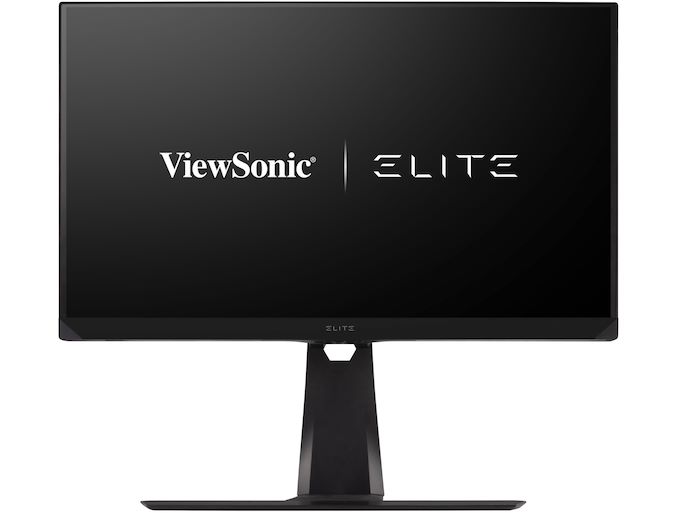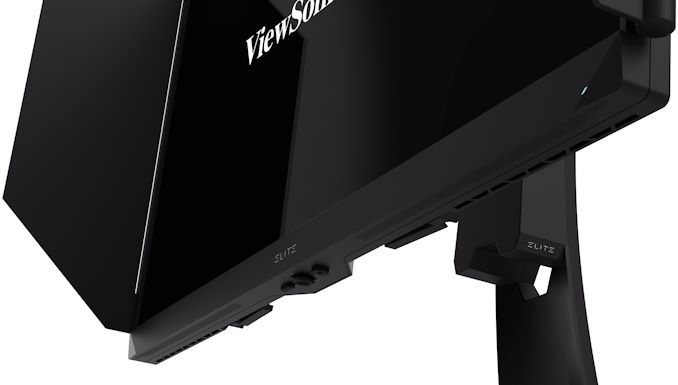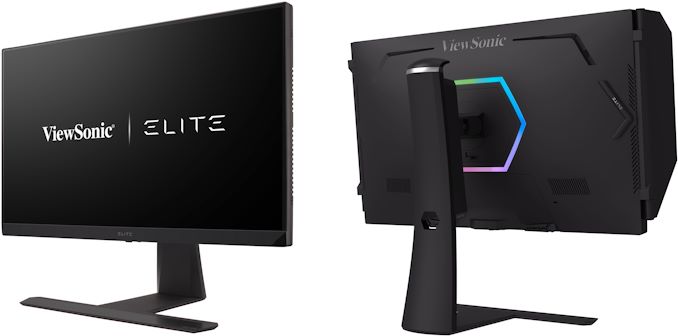ViewSonic Introduces Elite XG270QG Monitor: WQHD w/DCI-P3 and 165 Hz G-Sync
by Anton Shilov on September 30, 2019 9:30 AM EST
ViewSonic has introduced a new high-end gaming-focused display, the Elite XG270QG. The 27-inch WQHD monitor uses a Nano IPS panel that offers all the flair you'd expect from a gaming monitor, including a maximum refresh rate of 165 Hz with G-Sync support, but ViewSonic is also focusing on color quality as well, supporting a surprising 98% of the DCI-P3 color space. As a result, while the monitor is primarily positioned for gaming, its characteristics should be good enough even for prosumers with color-critical workloads.
The key feature of ViewSonic’s Elite XG270QG display is LG 27-inch Nano IPS panel with a 2560×1440 resolution. The panel and backlighting system supports a maximum brightness of 350 nits, a 144/165 Hz refresh rate (normal/overclocked), and 1 ms GtG response time. Nano IPS panels made by LG feature nanoparticles on the screen’s LED backlighting that absorb excess light wavelengths and according to the company, improve the intensity, purity, as well as the accuracy of the on-screen colors.
Along with a refined backlighting system, the Elite XG270QG can display 1.07 billion colors (8-bit + A-FRC) and covers 98% of the DCI-P3 color space. And, showcasing that ViewSonic isn't just after gamers with the monitor and is looking to tap into the prosumer market as well, the monitor has optional light-shielding barriers on the sides to ensure consistent image quality even in bright ambient lighting.
For gamers, it is important that the monitor supports NVIDIA’s G-Sync variable refresh rate technology with up to 144/165 Hz maximum refresh rate. Regrettably, ViewSonic says nothing about the G-Sync range of its Elite XG270QG.
Given its positioning, the ViewSonic Elite XG270QG comes with an adjustable stand featuring an integrated mouse bungee, headphone hook, RGB ambient lighting on the back, and a brushed aluminum base. Meanwhile, the monitor offers the usual input options, with both a DisplayPort input as well as an HDMI input.
| The ViewSonic Elite 27-Inch Gaming Display with Nano-IPS | ||
| Elite XG270QG | ||
| Panel | 27" IPS | |
| Native Resolution | 2560 × 1440 (16:9) |
|
| Refresh Rate | 144 Hz (165Hz OC) | |
| Dynamic Refresh Rate | Technology | NVIDIA G-Sync |
| Range | ? | |
| Response Time | 1 ms (gray-to-gray) | |
| Brightness | 350 cd/m² | |
| Contrast | ? | |
| Color Gamut | 98% DCI-P3 | |
| Viewing Angles | 178°/178° horizontal/vertical (?) | |
| Curvature | none | |
| Inputs | 1 × DisplayPort 1.2 1 × HDMI 2.0 |
|
| USB Hub | 3x USB-A 3.0 | |
| Audio | 2 W speakers | |
| Proprietary Enhancements | ? | |
| Stand | Height | yes |
| Tilt | yes | |
| Swivel | no | |
| Power Consumption | Idle | ? |
| Typical | ? | |
| Maximum | ? | |
| MSRP | $599.99 | |
ViewSonic’s Elite XG270QG will be available this November at a price of $599.99.
Related Reading:
- LG Unveils 27 and 37.5-Inch IPS Monitors with 1 ms Response Time
- MSI’s Prestige PC341WU 5K 34-Inch Professional Monitor Now Available
- LG Announces the 5K UltraWide 34WK95U: A 'Nano IPS' Monitor with a HDR600 Badge
- LG Develops ‘Nano IPS’ LCD, Unveils 32UK950 4K Display with DCI-P3, HDR600, TB3
- GIGABYTE’s Aorus CV27Q Curved ‘Tactical’ Monitor: 165 Hz QHD With FreeSync 2
- Iiyama Launches G-Master GB2760QSU Display: WQHD at 144 Hz
Source: ViewSonic












33 Comments
View All Comments
Smell This - Monday, September 30, 2019 - link
I like ViewSonic stuff but using late-2017 LG tech on late-2019 monitors with a $600 price tag is !$#@%^#! sheet.AND, not flaming, but the woods are full of 27-inch $350-$400 IPS panels with sRGB 99 percent Color Gamut and AMD FreeSync technology . . .
Smell This - Monday, September 30, 2019 - link
It must be the RGB ambient lighting on the back (rolling eyes). It dang-sure is not the
USB 3.1 type-C...
skaurus - Monday, September 30, 2019 - link
It seems that first display with Nano IPS (32UL950) was released just a year ago, and it had 4k panel. So panel for this monitor was made somewhat later, and given its refresh times, this is especially likely.Also, no wonder that DCI-P3 and G-Sync are going to be more expensive than sRGB and Freesync.
SmCaudata - Monday, September 30, 2019 - link
The LG branded monitor using this panel just launched a month or so ago. I mean, if you are saying LED backlit monitors are "old tech" then I guess, but this panel as far as I understand is actually new. You are basically paying $100 for the g-sync in this vs the Freesync LG.Also, this is 98% of DCI-P3 which is wider than pretty much anything else out there right now.
Personally, I'd love to see this panel with some local dimming for true HDR, but other than that, this panel is the best 27" IPS out right now.
imaheadcase - Monday, September 30, 2019 - link
I still don't get why people like HDR, i guess no one ever messes with brightness before on a monitor.SmCaudata - Monday, September 30, 2019 - link
Local dimming makes a huge difference. That white text on a black screen will no longer leave a stripe of dark gray.All it all, it brings visual quality closer to that of OLED with better brightness, lower cost, and without worry of burn in.
dullard - Monday, September 30, 2019 - link
It is quite a pain to have to change brightness with every different software, or even every few minutes within the same application. Think going from a dark scenes to day scenes in a game or a movie and having to change the brightness back and forth. For people into photography, it is a must to be able to display both whites and blacks in the same image.PeachNCream - Monday, September 30, 2019 - link
Really? It's just a Fn key combination thing and takes a half second to hold the key down and then mash another key a couple of times to make changes.dullard - Monday, September 30, 2019 - link
Do you really think people want to mash keys every time the scene changes in a game or movie? Really? And when people look at photos, are they to look at the dark areas, mash keys, then look at the light areas and mash keys again for the same photo? If you don't like HDR, that is fine, there are many many monitors for you. But some of us want to be able to see details in the dark images and light images at the same time.PeachNCream - Monday, September 30, 2019 - link
Yes, I do think people use their keyboards constantly when interacting with their computers.